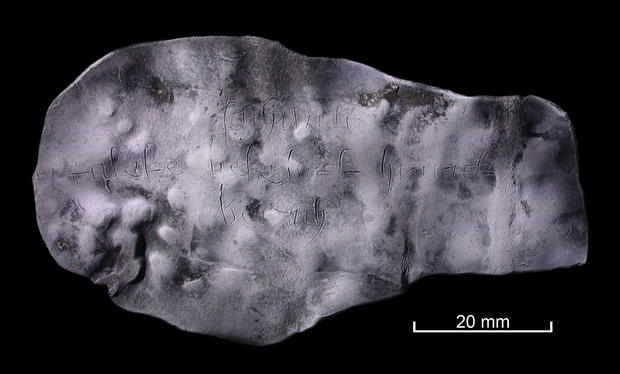
Ancient “curse tablet” targeting unlucky pair unearthed by archaeologists in Germany
Archaeologists probing a construction site in northern Germany recently unearthed a cryptic artifact that they believe dates back to the 15th century: a medieval “curse tablet,” with an inscription seemingly directed at two specific people.
The tablet was made from a small slab of lead, which was rolled up and “inconspicuous” when archaeologists discovered it beneath a latrine at the site in Rostock, a coastal city where construction for a town hall building was underway, the city said in a translated news release.
Curse tablets were often hidden in places “where they were difficult or impossible to find” so “the cursed ones shouldn’t find out about the impending disaster,” according to the release, which added that obscurity meant the tablet’s “damaging magic could therefore unfold in peace.”
Archeology in Mecklenburg-Western Pomerania
When researchers unrolled the piece of metal, they found a handwritten message in Gothic script that was hard to see with the naked eye. They ultimately deciphered the lettering as a clear curse, targeting a woman named Taleke and a man named Hinrik with its bad omen. According to archaeologists, the script read, “sathanas taleke belzebuk hinrik berith,” which they interpreted as a call summoning Satan and the demonic spirit Berith against the unlucky pair, for one reason or another.
1,500-year-old lead tablet found in an ancient theater in present-day Israel had Greek inscriptions that summoned demons to harm a rival dancer, and 2,400-year-old tablets discovered in Athens called on gods of the underworld to harm a group of tavern keepers, LiveScience reported.
The tablet discovered in Germany was not the first archeological find in Rostock, according to the city. Ansorge was also involved in a project at the same town hall construction site where they unearthed Valencian chandelierware earlier this year. Experts say the well-preserved bowl was made in Valencia, Spain, at some point during the 15th century.
Emily Mae Czachor
Source: cbsnews.com